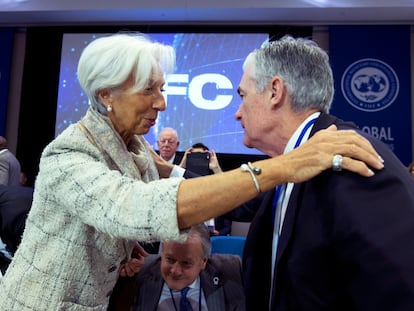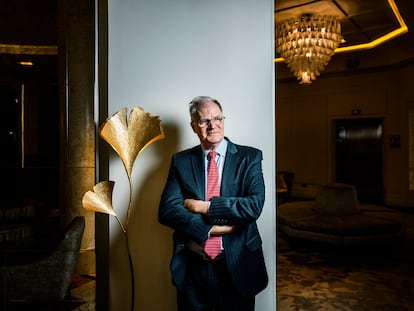BlackRock, Vanguard and Norges Bank dominate the Spanish banking world
In the last few years, the three funds have jockeyed into privileged positions in listed Spanish banks
BlackRock, Vanguard and Norges Bank are now the new owners of Spanish banks. In the last few years, the three funds have acquired privileged packages of shares in listed entities worth €17.505 billion, representing 12.3% of the combined capitalization of the banking sector.
The holdings of individual entrepreneurs have been diluted, and funds and other investment schemes have taken over the main share of Spanish banks. However, one must keep in mind that the shares held by these entities have been gained through the investment funds that they manage on behalf of their clients. In other words, it is not that these entities have bought securities directly on a massive scale for themselves, but rather that they have been accumulating shares through investment products for their clients.
In general, it is Spain’s largest banks that have found themselves dominated by these funds and investment firms, and in which capital is most widely distributed, with no large sums controlling a big piece of the pie.
The power of funds
Sabadell is the bank with the most widely distributed capital among its shareholders. The top ten holders of a stake in the Catalan bank account for just 14% of the shares. The top position is held by Mexican businessman David Martínez Guzmán, who owns 3.45%, valued at some €211 million. In second place is Vanguard, with 3.3%, and in third, Norges Bank, with 3%.
Twenty percent of BBVA’s capital is in the hands of its main shareholders, with the ten largest investors being banks and fund managers. The top three positions are held by funds that have carved a strong niche in Spanish banking: BlackRock with 5.98%, Vanguard with 3.93% and Norges Bank with 3.03%. In the case of BBVA, there is no individual entrepreneur or holding company among the main capital positions, though the Telefónica communications company owns 0.78% share, valued at around €328 million.
At Santander, the shareholder structure is more concentrated, and the top ten shareholders account for approximately a third of the bank’s capital. These are practically all funds and other banks that have accumulated shares through the sale of their products. BlackRock is the leading investor with 9.04%, which at market prices is valued at €5.203 billion. In second place, Crédit Agricole holds 3.59% and Vanguard controls 3.42%. Among the top shareholders is Javier Botín-Sanz de Sautuola y O’Shea, with 1.12%, worth around €645 million.
Capital concentration
Practically half of Bankinter’s capital is concentrated in the hands of its top ten shareholders. The bank’s former chairman, Jaime Botín, is its largest investor with 23.19%, which he controls through the asset-holding company Cartival. The Asturian businessman Fernando María Masaveu controls 5.31% — worth around €285 million — while the investment bank Lazard has 3.03%. Bankinter’s main shareholders also include Vanguard (2.68%), BlackRock (2.6%) and Norges Bank (2.51%), all regular investors in Spanish banks.
CaixaBank is another in which the capital is concentrated among its main investors, with the top ten shareholders accounting for 63.9% of the shares. The largest shareholder is Criteria Caixa, the investment arm of the Caixa Banking Foundation with a 32.23% stake, which is valued at around €9.115 billion. This is the largest stake held by a single investor in any Spanish bank. Also noteworthy is the State’s stake through the Executive Resolution Authority, or FROB, of 17.3%, worth around €4.893 billion, which it acquired after CaixaBank’s merger with Bankia. The state agency has the job of gradually relinquishing its share of the bank’s capital, aiming first to recover as much of the funds provided in public aid during the past financial crisis as possible. Recently, the government extended the maximum legal deadline for the FROB to complete the divestment to 2025.
The major Spanish banking funds are also among CaixaBank’s main shareholders: BlackRock has a 4.73% position, Vanguard 1.77% and Norges Bank 0.68%.
Unicaja is the entity with the highest concentration of capital among its main shareholders. The top ten investors in the Malaga bank account for 65.5% of the shares. In the distribution of its capital, there is a significant presence of investors linked to the Andalusian business sector. Also noteworthy is the 30.2% stake held by the Unicaja Foundation, valued at around €821 million, and the 8.54% stake held by Indumenta Pueri, the company owned by Mayoral. Meanwhile, the businessman Tomás Olivo, known for being one of the main shopping center promoters in Andalusia, holds 6.74%. And recently, the insurer Santalucía raised its position to 3.4%, after the Oceanwood fund sold practically all of its shares. Oceanwood was linked to the former Liberbank, and once the board decided to dismiss Manuel Menéndez as CEO, it decided to get rid of its stake.
Large funds also control significant stakes in Unicaja; namely, Norges Bank with 5.02%, Vanguard with 1.54% and BlackRock with 0.83%.
Book value
Spanish banks, and European banks in general, are still trading below their book value. The decade of low interest rates between 2012 and 2022 made it difficult for banks to generate income, which led to falling share prices. With the outbreak of the Covid-19 pandemic, banks were forced to make billion-dollar provisions that caused profitability to plummet, and consequently making already low valuations plunge further.
The European Central Bank’s ban on dividend payouts during 2020 also left investors with little reason to invest in the banking sector. However, the shift in monetary policy implemented in July 2022, entailing interest rate hikes, has caused the sector to boom once more. It is now recording record revenues and profits, which has led, in the last year, to a narrowing of the gap between its stock market value and book value.
Shareholders strengthen their positions through buybacks
Remuneration policy. In recent years, investors in the main banks have increased their positions without acquiring new shares, thanks to the share buyback programs implemented as part of the shareholder remuneration policy. Due to the low share price of the banks and to the excess capital accumulated, Santander, BBVA, CaixaBank and Sabadell have all launched share buyback programs. On the one hand, these schemes make it possible to amortize the treasury stock acquired, and reward shareholders by increasing the value of the securities in circulation. On the other hand, by reducing the share capital, shareholders see their stake increase without having acquired new securities, which is beneficial when it comes to receiving the cash dividend.
Sign up for our weekly newsletter to get more English-language news coverage from EL PAÍS USA Edition
Tu suscripción se está usando en otro dispositivo
¿Quieres añadir otro usuario a tu suscripción?
Si continúas leyendo en este dispositivo, no se podrá leer en el otro.
FlechaTu suscripción se está usando en otro dispositivo y solo puedes acceder a EL PAÍS desde un dispositivo a la vez.
Si quieres compartir tu cuenta, cambia tu suscripción a la modalidad Premium, así podrás añadir otro usuario. Cada uno accederá con su propia cuenta de email, lo que os permitirá personalizar vuestra experiencia en EL PAÍS.
¿Tienes una suscripción de empresa? Accede aquí para contratar más cuentas.
En el caso de no saber quién está usando tu cuenta, te recomendamos cambiar tu contraseña aquí.
Si decides continuar compartiendo tu cuenta, este mensaje se mostrará en tu dispositivo y en el de la otra persona que está usando tu cuenta de forma indefinida, afectando a tu experiencia de lectura. Puedes consultar aquí los términos y condiciones de la suscripción digital.
More information
Archived In
Últimas noticias
Maduro to be tried in the US for narcoterrorism and corruption
Maps of the US attack on Venezuela: Targets, airspace and deployed fleet
Venezuelans in exile: ‘This could be the end of a very dark chapter for Venezuela, but also the beginning of a time of uncertainty’
Key points of the military attack on Venezuela: Early morning bombings and a ‘captured’ president
Most viewed
- Alain Aspect, Nobel laureate in physics: ‘Einstein was so smart that he would have had to recognize quantum entanglement’
- David King, chemist: ‘There are scientists studying how to cool the planet; nobody should stop these experiments from happening’
- Mexico completes its trade shift with the entry into force of tariffs on China and countries without trade agreements
- Reinhard Genzel, Nobel laureate in physics: ‘One-minute videos will never give you the truth’
- Oona Chaplin: ‘I told James Cameron that I was living in a treehouse and starting a permaculture project with a friend’











































